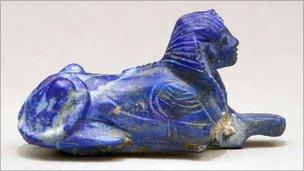Tutankhamun artefacts to be returned to Egypt
- Published

A Sphinx-shaped bracelet trinket is among the 19 items set to be returned
The Metropolitan Museum of Art in New York is to return 19 artefacts taken from Tutankhamun's tomb to Egypt.
The collection is made up of small figurines and jewellery, including a miniature bronze dog, a Sphinx-shaped bracelet decoration and a necklace.
The items will remain on display in Manhattan until June 2011.
Upon their return to Egypt, they will join the rest of the Tut collection at the new Grand Egyptian Museum in Giza, scheduled to open in 2012.
The Met decided to hand over the items after research by two of its curators substantiated their history.
"Because of precise legislation relating to that excavation, these objects were never meant to have left Egypt," said its director Thomas Campbell.
The items, he continued, "should rightfully belong to the government of Egypt".
"This is a wonderful gesture on the part of the Metropolitan Museum of Art," said Zahi Hawass, Egypt's antiquities chief.
"For many years the museum, and especially the Egyptian art department, has been a strong partner in our ongoing efforts to repatriate illegally exported antiquities.
"Thanks to the generosity and ethical behaviour of the Met, these 19 objects from the tomb of Tutankhamun can now be reunited with the other treasures of the boy king," he added.
Tutankhamun is believed to have died more than 3,000 years ago when he was about 18 years old.
His tomb, which included a gold coffin and mask, was discovered in 1922 by the English archaeologist Howard Carter.